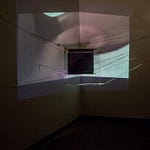After appreciating Roland Barthes, Death of the Author, I wondered how this can apply to other vocations including that of the artist. The "Death of the Artist" installation involved a wall painted blue; an aqua reminiscent of the colour chosen as the painted bottom of a pool, or the backdrop in a butterfly enclosure. 8 Palms lined up in their shipped pots, spaced with 7 chrysanthemums, sided by a log bench covered in epoxy, an electric Casio piano facing the audience of plants, two mirrors in each corner reflecting sunlit shapes. The sunlight streamed through a cutout in the roof of the building made by the artist inhabiting the space prior to the current installation. The piano was left plugged in and on, and was played by whoever wished to. Instead of a pianist, or a painter, or a performer, the viewers became the witness to the Death of the Artist. While the elements in the room were chosen somewhat autobiographically, the awareness such identity really did not matter was a focus. As the exhibition was situated in the graduate exhibition event for the college, in Los Angeles, a city noted for a wave of artists working in Institutional Critique or Social Practice, the installation made evident of conceptual art requiring some kind of mental game within the viewer or participant of the art. Mind Art.
Note: Play the video with the sound on to receive the "that's too real" conversation on this webpage where the video is embedded. https://rachelwolfe.com/power-plants-piano/ In that it’s best to hear for oneself, another reference of note is HC Andersen’s The Emperor Has No Clothes story.
What does "artist" mean, seems to have become an eye rolling question or something that must be treated with deep suspicion. Perhaps no one will agree on what it means today, and so we will learn the limits of difference and wonder about the detriments and virtues of consensus. There was a time, the artist meant becoming incredibly skilled and creating something deemed valuable to either the ruling class, the people, or both.
Thanks to modern and postmodern theory, the ability to think about the structure of life based on a multitude of awarenesses became available to anyone who wanted to find out. The demand for degrees of Master and PhD became a badge of eligibility to teach or attain certain jobs. The dandy uprising of the alternative or outsider artist burgeoned as a reaction to various dynamics within institutional models. As that dynamic could be a cookie all it’s own, this one will skip ahead to the identifiable social phenomena: artist as an identifiable myth. The story of where the artist came from and how that is tied their practice (as if in a perpetual state of never becoming a professional), is not only assumed to be the way for an artist to carve out a career but if a person making art goes against it, they may be cast aside from the "canon." This identity focus in art was taken up both by the pro and anti institutional positions. And so as ideas themselves may not not inherently good or bad, meaning fruitful or destructive, the rise of confusion and emotional posturing has become clearly more prevalent.
In this perspective, art and myth of artist became both advertising and war. This was widely written about the use of artists as a tool of propaganda. And instead of a ballistic material, the art object becomes a transitory object of the artists' identity, weaving a web of alliances, quite literally around the globe. The notion "anything can be art" widened the field of art as to making anyone questioning the blatant obtuseness of artist productions subject to being labelled in a sociologically negative way. And a label today mirrors that of the deployment of Brand. The layers of meaning within a Brand are something almost everyone is familiar with. Audi, Hermes, Target, Marlboro. So what happens post-branding? We are living in that now. Perhaps a nostalgic return to the labels formerly known as bad, such as "rural", "dull", "unsophisticated.”
These idealogical apparatae are increasingly apparent thanks to social media, the internet, as people found ways to weaponise media. The media itself is blamed, understandably as what information can come to pass before someone’s brain is not an area without bias. But the information on the internet is out there. The key has often been within the questions. So the blame cannot really be passed onto a media entity or this or that being evil or bad; the responsibility for knowing is within the individual. And that’s a tough task. In this way, there are no bad questions.
Moving along, as images are finally being embraced as the fictions they are, the documentary and referent qualities still exist. Humans are being forced to live with cognitive dissonance, and realize the idea anyone with a mobile device may be an unprofessional videographer, photographer, podcaster, editor, reporter or journalist, and that really creates a different quality to culture and life than when there was professionals. However, in the collapsing space between abject emotional experiences to public viewership creates clouds of confusion with people quick to tribally align, we have in our time a great fruit for understanding and clarity.
Instead of the obtuseness of "art" and the silencing nature of "ssshhhh, you shalt not speak unless degreed" scenario as written by Tom Wolfe in The Painted Word, we have means of voicing and creating harmony or discord at our individual will. As the Painted Word is a bit of a complicated version of the children's story, The Emperor's New Clothes by Hans Christian Andersen; why not actually say the emperor has no clothes on, be daring and actually say it.
Roland Barthes, Death of the Author, sent forth the notion the author is not the matter in the book. The reader takes from the signs on the page and imagines scenes and recreates a story that may or may not be related to the authors intention. The focus on the nuances in temporality may lose the attention of some readers yet clarifies an important aspect into the way the idea an artists' history and identity is taken up by society. If the Artist becomes a signifier of class or virtue; sucking the air out from the post-modernist ideals of agency, authorship, and freedom, the slide into social justice authorship is not a long one. The other aspect of post-modern ideals is the denial of any objective truth or reality, and the deployment of technology and the science as avenues for power. The logos of post-modernism becomes a rhetoric unto itself, a closed loop or solipsism, a monocle with which to see the world simultaneously promising rewards (work or income, food and housing) for some, while disregarding and disposing of the bodies and identities used.
In this way, Artists and their works become stones at which gallerists and societies throw at the other, and the generative energy Art has loses to nihilism. It’s really not terribly melancholic as it might seem. The difference is in the mind, and the monocle becomes multidimensional glasses, and we come back to embracing multitudes of voices and discerning that which generates thought, care, joy, play, commitment, fruitful work and meaningful life. Art doesn’t have to be social justice, or propaganda, but it would help if we opened up the minds of people to allow them access to the controversial perspectives in history that led to the creation of where we are today free from blame and accusation. This requires a bit of faith and belief in each other’s ability to become literate and behave as mature adults. And I feel we have the time. And it’s a great time now.

















Share this post